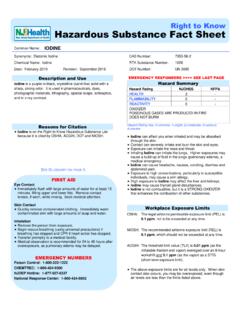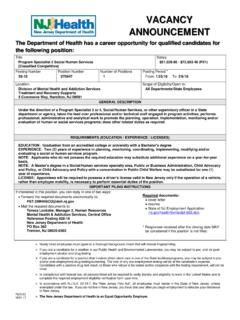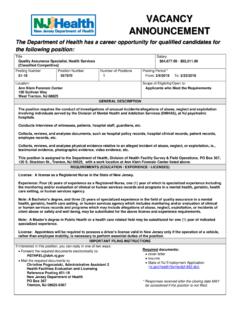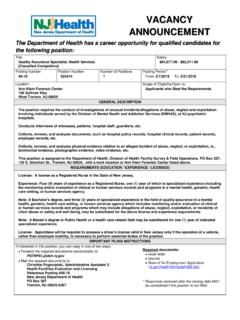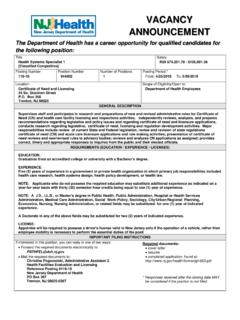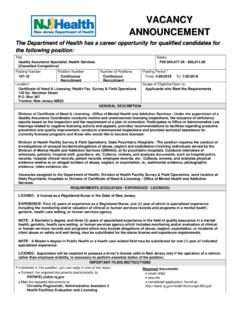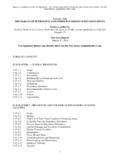Transcription of 1,4-DIOXANE HAZARD SUMMARY 1,4-Dioxane - New Jersey
1 Common Name: 1,4-DIOXANE . CAS Number: 123-91-1 RTK Substance number: 0789. DOT Number: UN 1165 Date: February 1996 Revision: March 2002. ---------------------------------------- --------------------------------- ---------------------------------------- --------------------------------- HAZARD SUMMARY . * 1,4-DIOXANE can affect you when breathed in and by * If you think you are experiencing any work-related health passing through your skin. problems, see a doctor trained to recognize occupational * 1,4-DIOXANE should be handled as a CARCINOGEN-- diseases.
2 Take this Fact Sheet with you. WITH EXTREME CAUTION. * ODOR THRESHOLD = 12 ppm. * Contact can cause eye and skin irritation and burns. * The range of accepted odor threshold values is quite * Breathing 1,4-DIOXANE can irritate the nose and throat broad. Caution should be used in relying on odor alone as causing coughing and/or shortness of breath. a warning of potentially hazardous exposures. * Higher exposure can cause you to feel lightheaded, dizzy and even to pass out. WORKPLACE EXPOSURE LIMITS. * Repeated contact can cause drying and cracking of the OSHA: The legal airborne permissible exposure limit skin.
3 (PEL) is 100 ppm averaged over an 8-hour * 1,4-DIOXANE may damage the liver and kidneys. workshift. * 1,4-DIOXANE is a FLAMMABLE LIQUID and a FIRE. HAZARD . NIOSH: The recommended airborne exposure limit is 1 ppm, which should not be exceeded during any 30 minute period. IDENTIFICATION. 1,4-DIOXANE is a colorless liquid with a mild Ether-like odor. It is used as a solvent and in textile processing, printing ACGIH: The recommended airborne exposure limit is processes and detergent preparations. 20 ppm averaged over an 8-hour workshift. * 1,4-DIOXANE may be a CARCINOGEN in humans.
4 There REASON FOR CITATION may be no safe level of exposure to a carcinogen, so all * 1,4-DIOXANE is on the Hazardous Substance List because it contact should be reduced to the lowest possible level. is regulated by OSHA and cited by ACGIH, DOT, * The above exposure limits are for air levels only. When NIOSH, NTP, DEP, IARC, HHAG, NFPA and EPA. skin contact also occurs, you may be overexposed, even * This chemical is on the Special Health HAZARD Substance though air levels are less than the limits listed above. List because it is a CARCINOGEN and is FLAMMABLE.
5 * Definitions are provided on page 5. WAYS OF REDUCING EXPOSURE. * Enclose operations and use local exhaust ventilation at the site of chemical release. If local exhaust ventilation or HOW TO DETERMINE IF YOU ARE BEING enclosure is not used, respirators should be worn. EXPOSED * Wear protective work clothing. The New Jersey Right to Know Act requires most employers * Wash thoroughly immediately after exposure to to label chemicals in the workplace and requires public 1,4-DIOXANE and at the end of the workshift. employers to provide their employees with information and * Post HAZARD and warning information in the work area.
6 In training concerning chemical hazards and controls. The addition, as part of an ongoing education and training federal OSHA HAZARD Communication Standard, , effort, communicate all information on the health and requires private employers to provide similar training and safety hazards of 1,4-DIOXANE to potentially exposed information to their employees. workers. * Exposure to hazardous substances should be routinely evaluated. This may include collecting personal and area air samples. You can obtain copies of sampling results from your employer.
7 You have a legal right to this information under OSHA 1,4-DIOXANE page 2 of 6. This Fact Sheet is a SUMMARY source of information of all Request copies of your medical testing. You have a legal right potential and most severe health hazards that may result from to this information under OSHA exposure. Duration of exposure, concentration of the substance and other factors will affect your susceptibility to any of the Mixed Exposures potential effects described below. * Because more than light alcohol consumption can cause ---------------------------------------- ----------------------------------- liver damage, drinking alcohol may increase the liver damage caused by 1,4-DIOXANE .
8 HEALTH HAZARD INFORMATION. WORKPLACE CONTROLS AND PRACTICES. Acute Health Effects The following acute (short-term) health effects may occur Unless a less toxic chemical can be substituted for a hazardous immediately or shortly after exposure to 1,4-DIOXANE : substance, ENGINEERING CONTROLS are the most effective way of reducing exposure. The best protection is to * Contact can cause eye and skin irritation and burns. enclose operations and/or provide local exhaust ventilation at * Breathing 1,4-DIOXANE can irritate the nose and throat the site of chemical release.
9 Isolating operations can also causing coughing and/or shortness of breath. reduce exposure. Using respirators or protective equipment is * Higher exposure can cause you to feel lightheaded, dizzy less effective than the controls mentioned above, but is and even to pass out. sometimes necessary. Chronic Health Effects In evaluating the controls present in your workplace, consider: The following chronic (long-term) health effects can occur at (1) how hazardous the substance is, (2) how much of the some time after exposure to 1,4-DIOXANE and can last for substance is released into the workplace and (3) whether months or years: harmful skin or eye contact could occur.
10 Special controls should be in place for highly toxic chemicals or when Cancer HAZARD significant skin, eye, or breathing exposures are possible. * 1,4-DIOXANE may be a CARCINOGEN in humans since it has been shown to cause liver, nasal cavity and gall bladder In addition, the following control are recommended: cancers in animals. * Many scientists believe there is no safe level of exposure to * Where possible, automatically pump liquid 1,4-DIOXANE a carcinogen. from drums or other storage containers to process containers. Reproductive HAZARD * Before entering a confined space where 1,4-DIOXANE may * There is no evidence that 1,4-DIOXANE affects reproduction.



